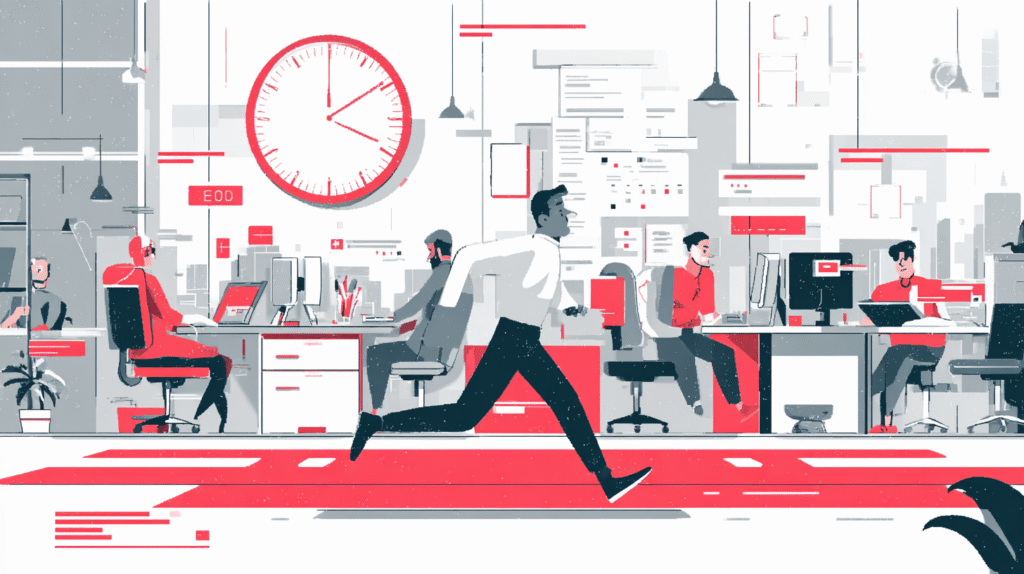Written by Dan Mintz, a leading productivity strategist and the founder of the 12-Week Breakthrough Program. Wharton MBA, MIT Data Scientist, 3x Entrepreneur. Worked with dozens of people to transform their lives in 12 weeks.
The rise of Artificial Intelligence is rewriting the rules of work. The once seemingly safe career paths are being reshaped—or in some cases dismantled—by automation, AI agents, and large language models. The decay of technical skills is quicker than ever. Job descriptions evolve in months, not years. In this environment, the question is not just about how do I keep up? The deeper question is: how do I future-proof my career so I can thrive—not just survive—in the age of AI?
The answer lies in combining two forces:
- Human strengths AI cannot replace — creativity, judgment, empathy, leadership.
- A deliberate execution mechanism that creates the space to build and adapt those strengths in short, repeated cycles.
That brings us to the 12 Week Year, and its evolution, the 12 Week Breakthrough. Together they provide a practical, research-based operating system—a life OS—to help you consistently transform yourself in response to disruption.
Why Future-Proofing Requires a System, Not Just Skills
Let’s assume I’m your devil’s advocate for a moment. If everyone agrees that human skills like creativity, empathy, and leadership are fundamentally more durable than technical knowledge, why wouldn’t we just practice them? What do we need a system like the 12 Week Year for?
Here’s the issue: awareness is not execution.
- MIT Sloan research on knowledge work reminds us that we lose 28–40% of productive time to distraction and poor prioritization (Lufkin, 2023).
- Locke & Latham’s Goal-Setting Theory shows that vague intentions underperform compared to specific, challenging, time-bound goals with feedback (2002).
- History tells us that annual planning collapses in the face of uncertainty. By December, the world has fundamentally shifted.
So sure, you could take a chance on OKRs, agile sprints, habit tracking, or willpower. But most systems either operate on the wrong horizon (annual OKRs), or are purely tactical (habit apps) without strategic coherence. The 12 Week Year is different because it compresses execution into 12-week cycles—long enough for results, short enough to pivot.
That makes it the right fit for an exponential environment in which AI shifts work every quarter.
The Vision Pillar: Anchoring Transformation
In the age of AI, your career may not just be nuanced—it may change completely. That requires more than goals; it requires a vision strong enough to transform you into a new type of professional.
Vision is both an anchor and compass:
- Anchor: Keeps you steady as roles, tools, and industries shift.
- Compass: Prevents you from clinging only to outdated value when AI transforms your work.
Example Vision Statement:
“I am a strategist who adapts in 12-week cycles, fluent in AI, yet I am defined by creativity, judgment, and leadership that no machine can replace.”
This identity shift is how you move from surviving automation to thriving in AI-human systems.
One-Year Goals: Strategic Benchmarks
Vision sets direction. But you also need a bridge between vision and execution cycles. That bridge is 1-Year Goals.
1-Year Goals are not to-do lists; they are strategic benchmarks that prove transformation is happening. Think of them as quarterly arcs of change.
Example 1-Year Goals:
- Implement 8–12 AI automations that save at least 10 hours per week.
- Deliver four flagship assets (talks, workshops, case studies) that demonstrate judgment + creativity with AI.
- Redesign workflow so 40% of tasks are delegated to AI while protecting three weekly deep work blocks.
- Publish 40–50 high-signal posts to build trust and credibility.
- Launch one AI-supported offer and secure at least two clients.
These outcomes are specific, measurable, and proof-focused. They promote your evolution from operator to orchestrator.
12-Week Goals: Adaptive Targets
Annual goals are too slow. That’s why the 12 Week Year breaks them into 12-Week Goals—short, adaptive targets that reflect career shifts in real time.
Examples:
- AI Fluency Goal: By Week 12, I’ve designed and implemented 3 automations that save me at least 5 hours/week.
- Human Advantage Goal: By Week 12, I’ve delivered one high-impact presentation that combined AI data with my judgment.
- Orchestrator Goal: By Week 12, 20% of my weekly tasks are delegated to AI while protecting three deep work blocks each week.
Each cycle you adapt. Each cycle you get stronger. This is future-proofing on schedule.
Planning Phase: The 12-Week Execution Plan
Planning is where the 12 Week Year becomes a tactical playbook:
- Key Initiatives: Identify 2–3 actions that directly drive your 12-week goals.
- Weekly MITs (Most Important Tasks): Translate initiatives into 3–5 concrete weekly actions. If they’re done, you win the week.
- Calendar Integration: Block time. Deep work doesn’t happen by accident.
This is where Cal Newport’s Deep Work (2016) runs in concert with James Clear’s Atomic Habits (2018). You protect time for cognitively demanding work while reinforcing your identity through consistent actions.
Defining Metrics: Lead & Lag Indicators
Metrics turn goals into scoreboards:
- Lag Measures: Results you want (promotion, revenue, recognition).
- Lead Measures: Inputs you control (deep work hours, automations tested, posts published).
In future-proofing, you need metrics that track both adaptability and output:
- Number of AI tools deployed.
- Human-centered outputs created (talks, posts, collaborations).
- Percent of tasks automated vs. human-led.
This is where 4DX (The Four Disciplines of Execution) (McChesney, Covey & Huling, 2012) adds depth: what gets measured improves—especially when reviewed weekly.
Weekly MITs: The Heartbeat of Execution
MITs are the weekly heartbeat of the system. They’re not to-do lists; they’re commitments.
Example (Week 1):
- Audit ongoing tasks; tag automation candidates.
- Prototype Automation #1.
- Outline Week 10 presentation.
- Publish two LinkedIn posts.
Each week you block time, measure MIT completion, and adapt. Over 12 weeks, these compound into transformation.
Scorekeeping & Accountability
No scoreboard, no game. Weekly scorecards track:
- Lead Indicators: Deep work sessions, automations built, posts published.
- Lag Indicators: Hours saved, opportunities created, tasks automated.
Accountability accelerates results. A 15-minute weekly accountability check—solo or with a partner—keeps you honest and sharp.
Integrating the Best Research & Books
The 12 Week Year unifies insights from the most influential productivity research:
- MIT Sloan EPOCH Framework: Human-intensive skills—empathy, judgment, creativity, leadership—are the future moat (MIT Sloan, 2023).
- Deep Work (Cal Newport): Future-proof skills require distraction-free focus (2016).
- Slow Productivity (Newport): Do fewer things, better—exactly what 12WY enforces (Newport, 2023).
- Atomic Habits (James Clear): Identity compounds through habits; 12WY ties them to goals (2018).
- Goal-Setting Theory (Locke & Latham): Specific, time-bound, challenging goals drive results (2002).
- 4DX & Traction: Execution beats strategy; lead measures and scorecards close the gap (Traction by Gino Wickman, 2012).
The Devil’s Advocate Revisited
Can future-proofing be done using other systems—Agile, OKRs, Getting Things Done, or habit trackers? Sure. But here’s why the 12 Week Year is superior:
- Compression: 12 weeks is long enough for results, short enough for adaptation.
- Focus: 2–3 goals per cycle prevent overload.
- Execution Rhythm: Weekly MITs and scorecards keep momentum.
- Identity Shift: Moves you from operator to orchestrator of AI-human systems.
Other methods may help, but the 12 Week Year is the cleanest, simplest, and most research-backed OS for transformation.
Conclusion: The 12 Week Breakthrough
Future-proofing isn’t about predicting which jobs survive AI. It’s about becoming the kind of professional who adapts deliberately, cycle after cycle.
The 12 Week Breakthrough—built on the 12 Week Year and enriched with research from MIT, Newport, Clear, and others—is that operating system. It:
- Anchors you with vision.
- Guides you with 1-year and 12-week goals.
- Drives execution with weekly MITs.
- Keeps you honest with scorecards.
- Ensures you evolve into a strategist, not just a task executor.
In a world where AI is moving fast, your career moat isn’t knowledge—it’s adaptability. And the 12 Week Year is the system that makes adaptability a habit.
One cycle at a time, you can transform, stay relevant, and build a future-proof career.
FAQ
🎭 Objection: “Future-proofing requires human skills. Fine. But why the 12 Week Year? Why not any other system—annual OKRs, Atomic Habits alone, agile sprints, or just self-discipline?”
- “Skills matter, not systems.”
- Objection: If I know I need empathy, creativity, judgment, etc., I can just practice them. Why add a framework?
- Rebuttal: Awareness ≠ execution. MIT’s research and Locke & Latham’s goal-setting theory prove that people vastly overestimate what they’ll do without structured cycles and feedback. Without a cadence, intentions drift.
- “There are plenty of systems already.”
- Objection: OKRs, agile sprints, Getting Things Done, even just habit trackers all exist.
- Rebuttal: Most either operate on the wrong time horizon (annual goals, too slow for AI’s pace), or are too tactical (lists of habits or tasks with no strategic coherence). The 12 Week Year uniquely compresses execution into a cycle long enough for results but short enough for pivots. It’s the perfect fit for exponential environments.
- “Isn’t this just project management in disguise?”
- Objection: Why not just use Asana, Jira, or agile stand-ups?
- Rebuttal: Tools and PM methods manage projects. The 12 Week Year manages you. It’s not a workflow system—it’s a life OS: vision, focus, habits, scorecards, accountability. Tools help you track tasks. The 12WY forces you to become the kind of person who executes, adapts, and measures in cycles.
- “Other systems teach focus too—why is this better?”
- Objection: Deep Work, Atomic Habits, Slow Productivity all say focus on fewer, better things.
- Rebuttal: True, but they’re principles, not operating systems. They tell you what’s important, but not how to operationalize across 12 weeks, weekly MITs, and scorecards. The 12WY is the bridge that translates their insights into weekly execution you can see and score.
📌 The Core Answer
Yes, you could cobble together pieces from OKRs, agile, Atomic Habits, Deep Work, and self-discipline. But most people won’t. They’ll stay fragmented.
The 12 Week Year’s unique value:
- Compression (12 weeks vs. 12 months) → matches the speed of AI disruption.
- Focus (2–3 goals only) → aligns with Slow Productivity.
- Execution rhythm (weekly MITs + scorecards) → translates Deep Work + Atomic Habits into measurable outcomes.
- Identity shift (operator → orchestrator) → aligns with MIT’s EPOCH framework for human resilience.
In other words: it’s not that you can’t future-proof with another system—it’s that the 12 Week Year is the cleanest, simplest OS that makes it inevitable.



